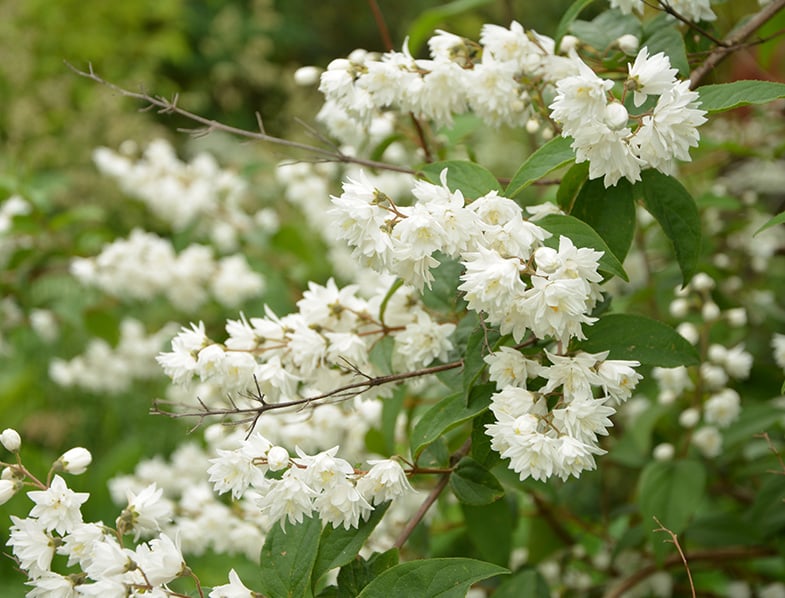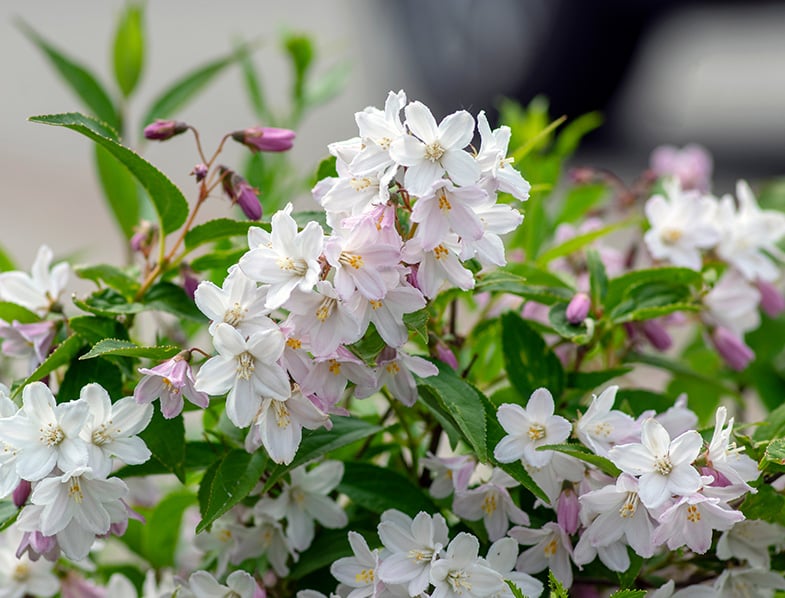Deutzia is a genus that contains about 60 species of lovely flowering plants. With a wide range of spread, Deutzia species are native to several regions of eastern and central Asia, Europe, and also Central America. However, the highest diversity of species can be found growing in China, where 50 species have been recognized in the wild.
These shrubby companions have become popular ornamental houseplants due to their interesting features.
They are suitable for both indoor and outdoor growing, but smaller varieties will look better in pots and placed on patio, windowsills, desks, or bookshelves.
Deutzia plants can be used in landscape decorations as ground covers, border plants, low hedges, and mass planting. They are seen very often in rock gardens near plants with similar growing requirements or other species of flowering plants.
Although Deutzia species come with a wide range of diversity, only a few of them are frequently cultivated. The species and varieties preferred by gardeners include D. gracilis (Slender Deutzia or ‘Nikko’), which is the most common specimen, D. scabra (Fuzzy Deutzia), cultivated in Japan for hundreds of years, and the hybrid D. × lemoinei that exhibits very abundant flowers.
About Deutzia Plants
- The small differences between Deutzia species are very difficult to identify. Many passionates often use microscopic details of their seed structure and leaf hairs.
- Their pleasant-looking appearance and low-maintenance features make Deutzia plants excellent companions for lilacs, mock oranges, deciduous azaleas, garden sage, pink dianthus, heuchera (coral bells), and nepeta (catmint).
- Some Deutzia species have some edible uses. For example, young leaves of D. scabra can be cooked and used in traditional recipes.
- In 1989, the most popular ornamental species known as D. gracilis ‘Nikko’ has gained the prestigious Gold Medal Award from the Pennsylvania Horticultural Society.
- Deutzia plants are very forgiving and can survive a wide range of environmental conditions like temperature, light, and soil. They do not require frequent fertilizing.
- While caring for these shrubs, take some time to inspect them for intruders. Deutzia plants are generally pest-free, but they can be bothered occasionally by aphids, mealybugs, scale insects, or spider mites.
- In case of infestations or just for ornamental purposes, established Deutzia plants can be rejuvenated by cutting back up to one-third of the branches to the ground level.
- There are no toxic effects reported regarding Deutzia plants. These shrubs can be grown safely near curious pets and children.

Deutzia Plants Features: An Overview
- Deutzia plants belong to the Hydrangeaceae family. Most species are deciduous, but some subtropical species are usually evergreen.
- Depending on the species, these shrubs can reach heights that range from 3.3 to 13.1 feet (1-4 m) and an equal spread in their natural habitat.
- The foliage is pretty simple, soft, greenish, slender, and comes along with serrated margins. Some varieties turn their leaves red in autumn.
- Their leaves grow opposite arranged on long stems that can have various shades of green or brown. When younger, their stems are mostly yellow-colored.
- They are composed of numerous arching branches that give these mound-forming shrubs a cascading or weeping look.
- From mid to late spring, Deutzia plants produce mesmerizing inflorescences that contain many branches paired in corymbs or panicles filled with tiny blooms.
- Their blooming season lasts for one or two weeks. During this period, Deutzia plants bloom sporadically and can become almost entirely covered in flowers.
- In general, their star-shaped or bell-shaped flowers form an overall clustered growth. They have five petals and appear mostly white-tinted, but they can exhibit interesting pink or reddish tones.
- The spent bloomings are followed by small fruits described as dry and brown capsules. The born fruits contain numerous seeds that can be collected and used in propagation.
Growing Deutzia Shrubs
As with most species of shrubs, you will not encounter any problems while growing and caring for Deutzia plants. On the contrary, these shrubs are very easy-going and can grow healthy and happy in almost any environment and growing conditions.
Moreover, they are known for their ability to bloom in shade. If you live in a region where days are more shaded than sunny, these shrubs can be a great choice for your garden next to your other babies!
In general, these shrubs prefer locations where they can receive plenty of bright and direct light. Whether you grow them outdoors, in a garden, or indoors, in pots, Deutzia plants should be placed in the sunniest area you can find.
If you cannot grow your shrubs in a well-lit place, no worries! All Deutzia species are tolerant of partial to even full shade all-day-round and will not affect their overall growth and health.
When it comes to temperatures, Deutzia shrubs are not as picky as you might think! Yes, they prefer mid-cool to slightly warmer temperatures, but they are also pretty hardy to extreme conditions. These plants can be grown outdoors in cooler regions, as they can survive in temperatures that drop to -4 °F (-20 °C) for long periods.

Planting Deutzia Shrubs
Deutzia plants can withstand a wide range of soils, but you should keep in mind that they prefer to have excellent drainage. However, they demand a soil that is also rich in organic matter to bloom at their best. You can also add one part of perlite to improve drainage.
Although Deutzia shrubs will benefit from fertilizer regularly, it is suggested to refrain from it when planting or during their first active growing period. If your Deutzia plants are established, you can feed them with a light and balanced granular fertilizer once every year in spring. The best fertilizers you can provide your plants with have a 10-10-10 composition of nutrients.
If you want your shrubs to always look healthy and fresh, you must prune them regularly each year. The spent flowers or those from the previous blooming period can be removed from the plants in early spring before the current blooming season. You can also cut off broken or dead stems in late winter or late spring to encourage new growth.
- Plant is delivered in a #2 size container. It is fully rooted in the soil and can be planted immediately upon arrival, weather permitting.
- For Best results, plant in usda zones 5-8. Mature Height is 3-4ft, mature spread is 3-5ft
- Stunning bright yellow foliage that holds its color without burn even in the sunniest parts of the landscape. Grows well in full sun or partial sun
- In late may, masses of buds open to clouds of Small, White, star-shaped flowers that really put on a show
- Plant will be dormant (no leaves) late fall through the winter months, this is normal. It will leaf out in spring
- Zones 5-8
- Mature Height: 1-2'
- Blooms: Spring
- Flowers: Pink
- Garden & Patio
- Mature Height and Spread: 2.5-4'
- Zones 5-8
- Sun
- Spring Bloomer
- Garden & Patio
Last update on 2025-08-27 / Affiliate links / Images from Amazon Product Advertising API
Watering Deutzia Plants
Deutzia plants are quite tolerant of drought and can generally survive without water for a week or even more. They will need watering more often than usual in the first two years after planting, as they must settle in their new environment first. And we have great news for you! If you live in a humid area where rainfalls are frequent or abundant, you can skip watering for good. Otherwise, the watering technique is simple and requires no extra effort on your part.
Deutzia plants are susceptible to root rot and will also not think twice before showing signs of under-watering. To avoid any possible complications, make sure you always check the soil before the next watering. If the top inch (2.5 cm) of soil feels dry to the touch, this is the perfect time to provide your thirsty plants with a nice and deep soaking.
During the hot summer months, these shrubs may require more water than you are already used to. However, you can water your plants once or twice per month when temperatures are cooler or during the winter.
Propagating Deutzia Plants
Nothing can be more rewarding than to fully understand your plants’ needs. If you are an experienced gardener, you already know how easy-going and friendly shrubs can be. If not, you can have a little fun propagating your Deutzia plants, as it is not as scary as you might believe! You can grow more of these beautiful and colorful shrubs by yourself through stem cuttings and eventually surprise your beloved ones with a gift. We guarantee that your family and friends will absolutely love them!

Deutzia plants respond best to propagation if the cuttings are taken at the end of summer. Within this method, you will want to use healthy semi-hardened or soft-wood stems that are in the process of hardening but present no brown barks yet. Once you have found the perfect stems, cut about 6 inches (15 cm) off them and remove the lower leaves until one or two pairs are left in the upper half.
For optimal results, many growers prefer to dip the cuttings in rooting hormone to boost their growth. You can also allow them to callous over in a warm and shaded place for a few days, but not all cuttings will survive this process.
When it comes to the growing medium, you should use a potting mix designed especially for cuttings or prepare your own by combining equal parts of river sand and peat moss. Moreover, make sure you maintain the substrate slightly damp, but not waterlogged.

Your Deutzia cuttings will develop a strong root system if they are protected from cooler temperatures and winter conditions. Thus, you must keep them in a location where temperatures do not get lower than 40 °F (5 °C). When the last signs of frost have passed, you can transplant your babies in their individual pots and care for them as for their mother plant.
In Conclusion
Shrubs are probably one of the easiest houseplants to grow and care for and Deutzia is no different! Take a leap of faith and find a nice place for this plant among your plant buddies, as you will not regret it. With minimal care and lots of love, Deutzia will be a pleasant companion for decades!




1 Comment
Can you tell me the variety of Deutzia, the first pink and white
photo in the ‘how to grow’ section.
Thank you